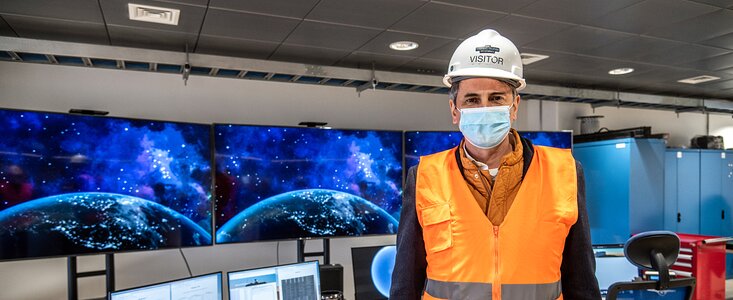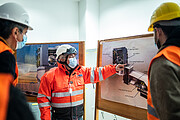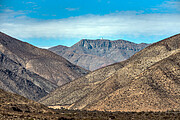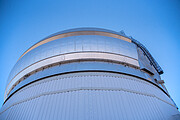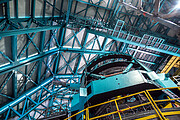Chilean Minister of Science Visits AURA–NOIRLab Facilities at Cerro Pachón
AURA in Chile Vice President and Director accompanied the Minister and the Coquimbo Region’s representative of the Science Ministry to visit Gemini South and Vera C. Rubin Observatory
13 August 2021
The Chilean Minister of Science, Technology, Knowledge and Innovation, Andrés Couve, accompanied by the Coquimbo Region’s representative of the Science Ministry, María José Escobar, visited the AURA–NOIRLab sites in northern Chile on 11 August 2021 to learn more about the latest developments. They were accompanied by Vice President and Director of AURA in Chile, Mario Hamuy, as they visited Cerro Pachón in the Chilean Andes with stops at Gemini South, part of the international Gemini Observatory, and the Vera C. Rubin Observatory construction site. Gemini Observatory and Rubin Observatory are both Programs of NSF's NOIRLab.
Minister Couve highlighted the importance of having science investments in Chile such as those made by AURA–NOIRLab, stating, “These mega-investments, in addition to having a great impact on science, also have a positive impact on the regional and national economy, whether in the creation of jobs, entrepreneurship, or in the transition to an economy based on knowledge.” Couve continued, “In this sense, the Rubin facility, for example, represents an anchor of cutting-edge technology that can be an economic engine, combining the possibilities for scientific research with possibilities for development.”
This was the first such visit since the pandemic began and participants observed all the required COVID-19 measures. “It was very positive that the national authorities were able to learn about the careful work that has been done to maintain the astronomical research with the minimum number of staff on site to take care of our teams during the pandemic,” said Hamuy.
Representative Escobar stated that, “the new scientific and technological capacities promoted by these new telescopes also contribute to the development of working groups in data science in the Region (of Coquimbo). Currently, the University of La Serena has a strong astronomy group [specializing] in data science that has even explored applications in other areas. These kinds of synergies are what we hope to occur with this astronomical knowledge: linking science with economic activity and development.”
Gemini South is one of Gemini Observatory's twin 8.1-meter-diameter telescopes, which boast a wide variety of optical-infrared capabilities. By incorporating technologies such as laser guide star adaptive optics and multi-object spectroscopy, astronomers can explore the Universe in depth. Gemini South is located at Cerro Pachón, while its Gemini North counterpart is located near the summit of Maunakea in Hawai‘i.
Rubin Observatory, located near to Gemini South at Cerro Pachón, will feature state-of-the-art technology that includes an 8.4-meter telescope with a unique 3-mirror design, creating an exceptionally wide field of view. It will operate at an automated cadence, exploring the entire visible southern sky every few nights. In addition, it will feature the largest digital camera ever built for astronomy: it is about the same size as a small car and weighs almost 2800 kg (3 tons).
“Couve and Escobar learned about the progress on the construction of the Vera C. Rubin facility project, which will have the largest digital camera in the world for astronomy and an automated data processing system,” said Hamuy “Thanks to this system, topics such as dark energy and dark matter will be studied, and catalogs of the Milky Way and the Solar System will be created.”
Dedicated computing facilities will process Rubin’s data in real time, sending public alerts globally within 60 seconds of detected changes in the sky. Rubin will generate approximately 20 million megabytes of data per night and its ten-year exploration will produce a 15-billion-megabyte catalog database.
More information
NSF’s NOIRLab (National Optical-Infrared Astronomy Research Laboratory), the US center for ground-based optical-infrared astronomy, operates the international Gemini Observatory (a facility of NSF, NRC–Canada, ANID–Chile, MCTIC–Brazil, MINCyT–Argentina, and KASI–Republic of Korea), Kitt Peak National Observatory (KPNO), Cerro Tololo Inter-American Observatory (CTIO), the Community Science and Data Center (CSDC), and Vera C. Rubin Observatory (operated in cooperation with the Department of Energy’s SLAC National Accelerator Laboratory). It is managed by the Association of Universities for Research in Astronomy (AURA) under a cooperative agreement with NSF and is headquartered in Tucson, Arizona. The astronomical community is honored to have the opportunity to conduct astronomical research on Iolkam Du’ag (Kitt Peak) in Arizona, on Maunakea in Hawai‘i, and on Cerro Tololo and Cerro Pachón in Chile. We recognize and acknowledge the very significant cultural role and reverence that these sites have to the Tohono O'odham Nation, to the Native Hawaiian community, and to the local communities in Chile, respectively.
Rubin Observatory is a joint initiative of the National Science Foundation (NSF) and the Department of Energy (DOE). Its primary mission is to carry out the Legacy Survey of Space and Time, providing an unprecedented data set for scientific research supported by both agencies. Rubin is operated jointly by NSF’s NOIRLab and SLAC National Accelerator Laboratory (SLAC). NOIRLab is managed for NSF by the Association of Universities for Research in Astronomy (AURA) and SLAC is operated for DOE by Stanford University.
Links
- Vera C. Rubin website
- Photos of Vera C. Rubin Observatory
- Videos of Vera C. Rubin Observatory
- Photos of Gemini South
- Videos of Gemini South
Contacts
Amanda Kocz
Press and Internal Communications Officer
NSF’s NOIRLab
Cell: +1 626 524 5884
Email: amanda.kocz@noirlab.edu
Luz María Aguirre
Head of Communications and Institutional Relations
AURA in Chile
Cell: +56 9 98714645
Email: LAguirre@aura-astronomy.org


